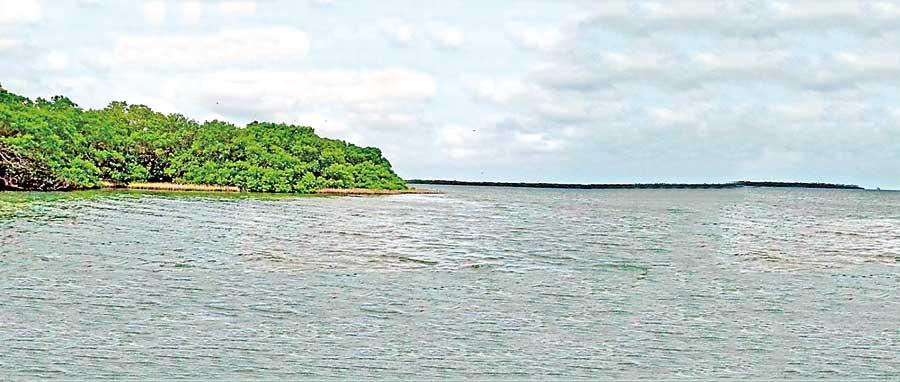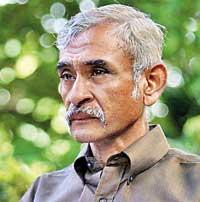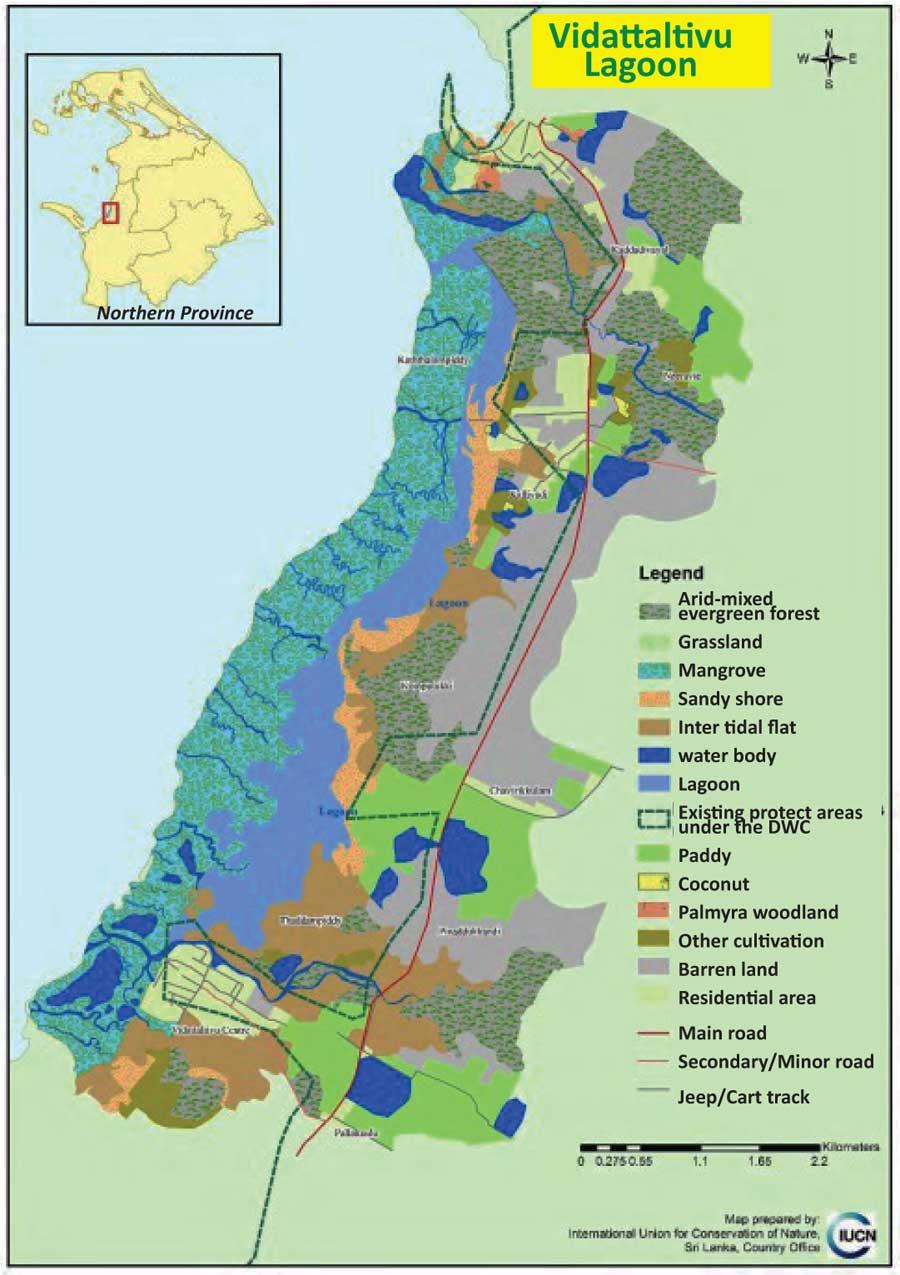Reply To:
Name - Reply Comment

The Vidattaltivu Nature Reserve home to three most important blue carbon ecosystems in Sri Lanka Image courtesy : WNPS
| VIDATTALTIVU NATURE RESERVE IS SRI LANKA'S THIRD LARGEST MARINE PROTECTED AREA SITUATED CLOSER TO THE VANKALAI SANCTUARY |

The Vidattaltivu Nature Reserve nestled in the Northern coast of Sri Lanka has been identified as home to some of the most important blue carbon ecosystems. This is why it was gazetted as a Nature Reserve in 2016 by the then Wildlife Minister Gamini Jayawickrama Perera. Blue carbon ecosystems, such as mangroves, salt marshes and seagrass meadows, store vast amounts of carbon in their soil and biomass. But, despite its importance in this era of rapid climate change, on May 6, the Minister of Wildlife and Forest Resource Conservation Pavithra Wanniarachchi issued orders to de-gazette part of the Vidattaltivu Nature Reserve via an extraordinary gazette No. 2383/05. It states that she has exercised the powers vested under the Flora and Fauna Protection Ordinance (FFPO), Section II – subsection IV and that the area specified in the appendix of the gazette will no longer be designated as part of the Vidattaltivu Nature Reserve.
Failing to walk the talk
Even though incumbent President Ranil Wickremesinghe had been appointing committees and secretariats to discuss and make policy level changes to combat climate change, his own cabinet ministers seem to be doing the opposite. Environmental groups have questioned the state as to how a minister could issue such an order sans proper consultations from experts and the cabinet of ministers.
Issuing a statement, the Wildlife and Nature Protection Society (WNPS) said that Sri Lanka has once again shown that the actions of the state don’t align with preaching following its move to de-gazette part(s) of Sri Lanka’s best blue carbon protected area in the midst of climate pledges.
According to WNPS, the move raises many questions:
1. As a nation that claims to champion climate change and engage in carbon financing, why are we de-gazetting our most important blue carbon ecosystem?
2. Why has due process not been followed?
3. Why has this decision been made in clear defiance of a report from a Technical Evaluation Committee that rejects the de-gazetting of the area?
4. Why are we disturbing the balance of a self-sufficient ecosystem which provided stability and food security to the surrounding communities even during the civil war?
5. Will this set a precedent, and seal the fate of the rest of our protected ecosystems across the island?
“The Vidattaltivu Nature Reserve is an area in which all three blue carbon ecosystems exist; storing vast amounts of carbon that help mitigate the impact of climate change. This vital ecosystem supports the lives of countless species, empowers livelihoods, and protects our coast from destruction.
“If even a single area within or around the Reserve is utilised for aquaculture, the impacts on our environment and the surrounding communities would be devastating and far-reaching–extending beyond what we could even imagine.
“We urge every possible individual, entity and interested party to speak up to safeguard this already fragile ecosystem,” WNPS said.
 This regulation or order by the Minister of Wildlife and Forest Resource Conservation Pavithra Wanniarachchi is flawed because no one knows how many hectares would be removed and from where in the Nature Reserve this section would be removed. As such, this particular regulation is very bad in law,”
This regulation or order by the Minister of Wildlife and Forest Resource Conservation Pavithra Wanniarachchi is flawed because no one knows how many hectares would be removed and from where in the Nature Reserve this section would be removed. As such, this particular regulation is very bad in law,”
– Dr. Jagath Gunawardana
A flawed and illegal process
Vidattaltivu has been declared as a Nature Reserve under the FFPO Section II - subsection I. “Once such an area is declared and if there’s a need to remove parts of it, then there is a procedure given under Section II - subsections IV and V,” said senior environmental lawyer Dr. Jagath Gunawardana.
“According to the provisions, there is a need to do an Environmental Assessment to decide whether the removal of such a portion would affect the integrity, ecology and the existence of the rest of the protected area, or if there are any adverse consequences from the removal of that area. Thereafter, the report has to be considered before a decision is being taken. After the decision is taken it has to be made into an order in the gazette and the gazette has to be presented in Parliament.”
With reference to Vidattaltivu, Dr. Gunawardena said that the need to get part of the Vidattaltivu Nature Reserve for aquaculture was mooted in 2017 and the National Aquaculture Development Authority (NAQDA) got the National Aquatic Resources Agency (NARA) to do an environmental assessment and that assessment had so many shortcomings. “Nevertheless the Wildlife Department appointed a panel of experts to go through it and the experts unanimously decided that this area should not be removed from the rest of the protected area because there will be severe adverse consequences if this removal is done. Subsequently the decision was conveyed to the Ministry of Fisheries and NAQDA, but in 2020 there was another move to remove part of it and there was another move in 2021 and this is the latest in this episode where the Minister has made an order which has been published in the gazette.”
But according to Dr. Gunawardana, this particular order is not specific as it doesn’t mention the area which will be removed including its extent and borders. “An order under any law has to be quite specific. It has to be specific in the sense that it has to mention the name of the area, the area that is exactly going to be removed, its extent and borders. In this particular instance, the schedule that has to show the area that is being removed has not been availed to the regulation. So this regulation or order by the Minister is flawed because no one knows how many hectares would be removed and from where in the Nature Reserve this section would be removed. As such, this particular regulation is very bad in law,” he added.
When asked if any experts were consulted before the decision was made, Dr. Gunawardana responded in the negative. “When the older report was perused by a group of experts, they decided that this area should not be removed. But they can’t rely on the same report and get a diverse opinion. As such there are serious procedural flaws in the process that need to be challenged. So we have been kept in the dark deliberately. What I fear is that according to the public response, the schedule will come later, so it would either be a very large extent of land or a small extent according to the public protest or perception and therefore they have deliberately kept the schedule off the record so that later on they could manipulate it and this is illegal,” he underscored.
A natural laboratory under threat
“Vidattaltivu was a protected area that wasn’t declared haphazardly,” said Chair/Professor–Department of Aquaculture and Fisheries at the University of Wayamba, Prof. Sevvandi Jayakody.
“After the war, one of the main decisions that was taken was to ensure that the haphazard development that happened in the South shouldn’t happen to people in the North. Between 2014-2019, the Northern Strategic Environmental Assessment and Report was done. When doing that report, all government agencies were involved, which included the Ministry of Fisheries, Department of Fisheries, NAQDA, NARA, DWC, etc. It was a very comprehensive assessment and the report identified areas that can be strategically developed for the benefit of the people. It also identified areas that should be set aside for people because they carried some important natural capital that has been sustaining the livelihoods of people. Areas that have the highest natural capital, not only sustained people, but they were biodiversity hotspots as well. It’s the biodiversity that’s the natural capital and Vidattaltivu is one such area that this report identified.”
Explaining its unique character, Prof. Jayakody said, “On land you find the dry zone forests, shrub forests then you start seeing some of the best salt marshes in the country, mud flats, mangroves and when you get into water you see vast expanses of seagrass, and further into the sea you start seeing coral reefs. This is like a natural laboratory for someone who wants to study these ecosystems. Another important factor is that there’s a deep connectivity amongst each one of these ecosystems. For instance, during the rainy season, the sediment from land comes towards the sea. Part of it will settle in mud flats and part of it will settle in salt marshes and the rest is again trapped by the mangroves, and whatever that wasn’t trapped settles in seagrass and gets sedimented there. But the coral reefs require tranquil, sediment-free water and the remaining sediment-free water reaches the coral reefs. This is why each one of these ecosystems manage one another,” she added.
“These ecosystems also thrive in some of the harshest environments, getting inundated twice during high tide and with unique adaptations to survive exposure to direct sunlight. “If I take another example to explain the ecosystem services at Vidattaltivu, the sea water, which is rich with salt, enters mangroves. The mangroves would then break the energy that it carries. Part of it would be absorbed into the soil, then the salt marshes and mud flats would take up the rest of the sea water so that the journey of the seawater further into the land is stopped. If this ecosystem is not there, you will not be seeing paddy farming going almost towards the coastline in this part of the country. If you travel from Mannar to Pooneryn you would see paddy being cultivated next to salt marshes. This is because all these ecosystems act as barriers for salt to go further inland. As a result, damage to one ecosystem would have profound impacts on the other.
“Hence, this area was declared a Nature Reserve after all government agencies gave their consent,” she added. “But sadly, now there is an order to de-gazette part of it. Rightfully, the cabinet decided to conduct an Environmental Impact study and see whether such a de-gazetting could have any impact on this protected area network. The study was done and submitted in 2019 and the DWC appointed a technical evaluation committee to study the report. The report itself had lots of errors to the point where one would wonder whether it was actually done by the right scientists. But, even though the report didn’t adhere to the Terms of Reference that were given, by looking at the contents of the report, it was crystal clear that it wasn’t an ecosystem that should be de-gazetted. When the DWC clearly said that the Vidattaltivu Nature Reserve cannot be de-gazetted, someone had the power to reverse the decision. So, who has such power to overrule a decision given by the cabinet of ministers?” Prof. Jayakody questioned.
A call to protect blue carbon ecosystems
“Vidattaltivu is also one ecosystem that has an extensive network of three blue carbon ecosystems including salt marshes, seagrass and mangroves. The world knows that these three ecosystems have the highest ability to store carbon at a time when we are already experiencing the impact of global warming. The world is racing to protect and restore blue carbon ecosystems. The world is pumping a lot of money to restore these ecosystems. But restorations happen at a piecemeal rate. This is why the world is saying that if you have blue carbon ecosystems, protect them at all costs because it is our future bank guarantee against climate change,” Prof. Jayakody said.
She added that Sri Lanka championed the Mangrove Ecosystems and Livelihoods under the Blue Charter in the Commonwealth. “Sri Lanka along with the Government of Indonesia came up with a resolution at the United Nations Environmental Assembly where we talked about blue carbon ecosystems and livelihoods. This year we won the UN flagship award for mangrove ecosystems and restoration. As such we have set so many examples and Sri Lanka is one country that has a national policy to protect mangrove ecosystems. We have done so much and we have been applauded. The President is talking about a climate change university etc. and when we have such a leadership, how is it that we are doing exactly the opposite?”
Impact of shrimp farming
The rapid expansion of shrimp farming along the North-western coastline and in lagoons such as Chili’s and Negombo is one of the main drivers of mangrove loss. In 2017, NAQDA developed a proposal for a 1,000 hectare aquaculture industrial park that would allow private parties to carry out various aquaculture projects and farming species such as marine fin fish, crabs and exotic species of shrimp. The project identified three sites with one lying within the Vidattaltivu Nature Reserve. Hence, the plan was to de-gazette part of the Nature Reserve.
According to the former NAQDA Director General, the plan was to set up an aquaculture industrial park on 1,423 hectares at Vidattaltivu. But this extent of land was brought down to 1,171 hectares following a ‘study’ which recommended that the park could be built provided that a few conditions are being fulfilled.
“Shrimp farming is a carbon intensive industry and is going to destroy our most important and largest connected nature reserve in order to pave the way for a carbon-intensive industry?” Prof. Jayakody questioned further.
“This is an injustice to the people in the North because it is for these people that the Strategic Environmental Assessment was conducted. It was for their benefit that these areas were set aside. They have been fishing for years. Some of the best crabs and shrimps come from this area. We are yet to know the species that will be cultured if this area has been removed for shrimp farming. We can speculate at the moment because NAQDA is promoting Litopenaeus vannamei or the white leg shrimp which itself was brought to the country by violating the law. It was brought without a proper assessment and by claiming that it is disease-free. So what kind of diseases would be introduced to the North if this species is cultured?” she added.
When inquired, NAQDA Director General Dr. J. M. Asoka said that even though a request has been made to release land for the proposed aquaculture development park in Vidattaltivu, the Fisheries and Wildlife Ministries have not yet responded. Speaking to Daily Mirror, DWC Director General Chandana Sooriyabandara said that the proposal to develop the aquaculture park had been there for a long time. “It was developed somewhere around 2019 and following this proposal the Fisheries Ministry sought approval to de-gazette part of the Nature Reserve for this purpose. Even though they had asked for over 1,000 hectares the EIA study recommended that around 169 hectares of land could be used for this project. This is the final decision taken by the cabinet of ministers and the gazette was recently signed by the Wildlife Minister. However, this is not a new turn of events because this matter had been discussed and debated for a long time. When asked which part of the Nature Reserve had been de-gazetted, Sooriyabandara responded in the negative. Responding to claims regarding the flawed EIA process, Sooriyabandara said that the DWC’s technical evaluation committee followed all guidelines and technical considerations as the project approving body of the EIA report. “But anybody could challenge it,” he added. Several attempts to contact Minister of Wildlife and Forest Resource Conservation Pavithra Wanniarachchi to inquire as to what and who prompted her to take this decision without having proper consultations and why the area that had been de-gazetted was not released to the public, proved futile. |

Map of Vidattaltivu